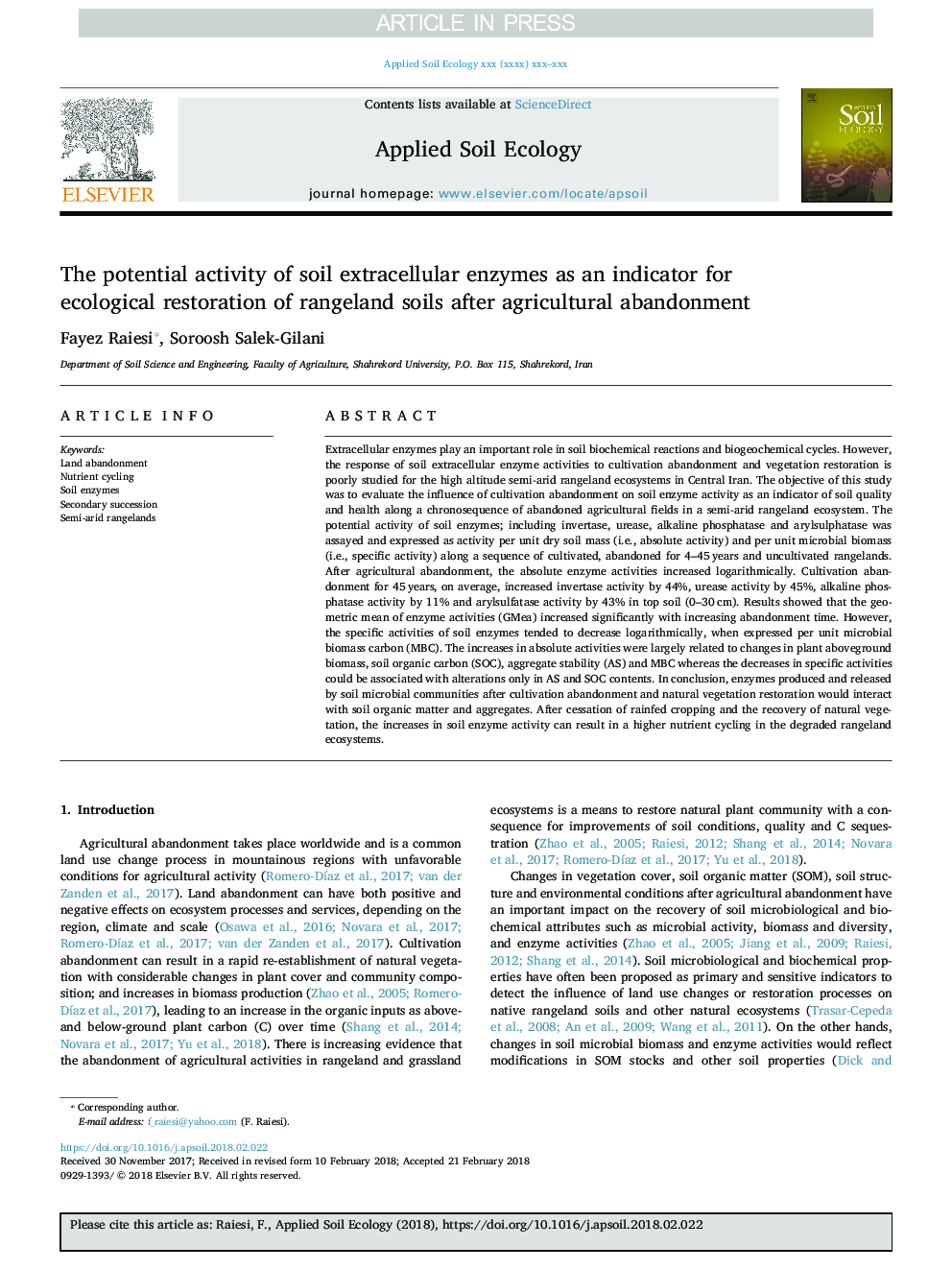| کد مقاله | کد نشریه | سال انتشار | مقاله انگلیسی | نسخه تمام متن |
|---|---|---|---|---|
| 8846679 | 1617757 | 2018 | 8 صفحه PDF | دانلود رایگان |
عنوان انگلیسی مقاله ISI
The potential activity of soil extracellular enzymes as an indicator for ecological restoration of rangeland soils after agricultural abandonment
ترجمه فارسی عنوان
فعالیت بالقوه آنزیم های خارج سلولی خاک به عنوان شاخصی برای بازسازی اکولوژیک خاک های مرتعی پس از رها سازی کشاورزی
دانلود مقاله + سفارش ترجمه
دانلود مقاله ISI انگلیسی
رایگان برای ایرانیان
کلمات کلیدی
رها کردن زمین، دوچرخه سواری تغذیه آنزیم های خاکی، جانشینی ثانویه، مراتع نیمه خشک
موضوعات مرتبط
علوم زیستی و بیوفناوری
علوم کشاورزی و بیولوژیک
بوم شناسی، تکامل، رفتار و سامانه شناسی
چکیده انگلیسی
Extracellular enzymes play an important role in soil biochemical reactions and biogeochemical cycles. However, the response of soil extracellular enzyme activities to cultivation abandonment and vegetation restoration is poorly studied for the high altitude semi-arid rangeland ecosystems in Central Iran. The objective of this study was to evaluate the influence of cultivation abandonment on soil enzyme activity as an indicator of soil quality and health along a chronosequence of abandoned agricultural fields in a semi-arid rangeland ecosystem. The potential activity of soil enzymes; including invertase, urease, alkaline phosphatase and arylsulphatase was assayed and expressed as activity per unit dry soil mass (i.e., absolute activity) and per unit microbial biomass (i.e., specific activity) along a sequence of cultivated, abandoned for 4-45â¯years and uncultivated rangelands. After agricultural abandonment, the absolute enzyme activities increased logarithmically. Cultivation abandonment for 45â¯years, on average, increased invertase activity by 44%, urease activity by 45%, alkaline phosphatase activity by 11% and arylsulfatase activity by 43% in top soil (0-30â¯cm). Results showed that the geometric mean of enzyme activities (GMea) increased significantly with increasing abandonment time. However, the specific activities of soil enzymes tended to decrease logarithmically, when expressed per unit microbial biomass carbon (MBC). The increases in absolute activities were largely related to changes in plant aboveground biomass, soil organic carbon (SOC), aggregate stability (AS) and MBC whereas the decreases in specific activities could be associated with alterations only in AS and SOC contents. In conclusion, enzymes produced and released by soil microbial communities after cultivation abandonment and natural vegetation restoration would interact with soil organic matter and aggregates. After cessation of rainfed cropping and the recovery of natural vegetation, the increases in soil enzyme activity can result in a higher nutrient cycling in the degraded rangeland ecosystems.
ناشر
Database: Elsevier - ScienceDirect (ساینس دایرکت)
Journal: Applied Soil Ecology - Volume 126, May 2018, Pages 140-147
Journal: Applied Soil Ecology - Volume 126, May 2018, Pages 140-147
نویسندگان
Fayez Raiesi, Soroosh Salek-Gilani,
